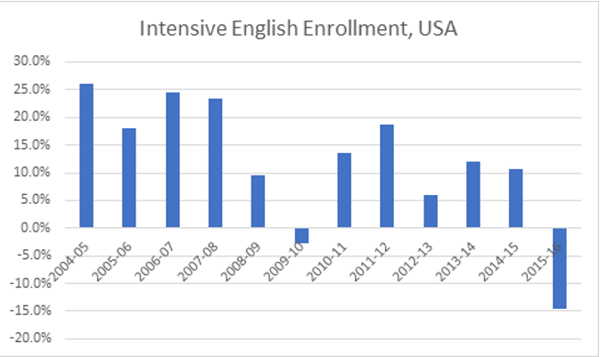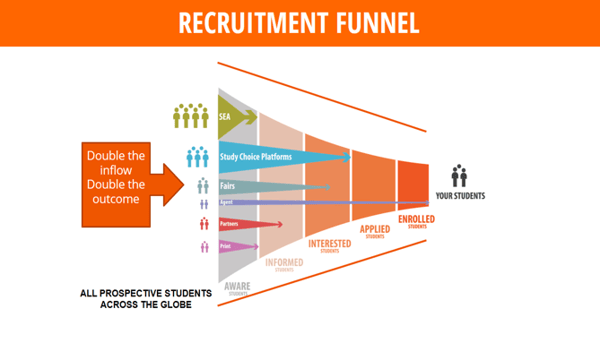Maintaining and Improving IEP Student Recruitment in Challenging Political Times

Although the total number of international students studying in the United States increased substantially over the past decade, 2015-16 was a challenging year, especially for Intensive English Programs (IEPs) in the United States.
After increasing numbers for the past 12 years, enrollments plunged more than 14 percent mainly due to political factors: decreasing oil prices impacted the Saudi student scholarship program (SACM) and tightened restrictions on non-degree study abroad programs. At the same time, Brazil’s political and economic crisis forced its government to cut generous scholarship programs from which Brazilian students benefited to learn English in the United States.
Many IEPs were heavily reliant on Saudi and Brazilian students, as well as Chinese students, and were hit hard in 2015 and 2016 as the number of intensive English students dropped drastically.

The Future Impact of the “Trump Effect”
After a turbulent 2015-16, many IEP providers in the U.S. are worried about the effect that the current political situation, termed “the Trump Effect” by some, will have on future enrolments. This concern is well founded, as anecdotal evidence already suggests that students are increasingly avoiding “unfriendly” policies in the United States or the UK and looking at other study abroad destinations like Canada for example.
So the question is: What can institutions do to work against this downward trend and increase student numbers again?
Mitigating the “Trump Effect”
To mitigate another tough couple of years for IEPs, schools can pursue two major strategies:
- Address the political situation: Promote your institution as a location where students will continue to learn, develop, and feel safe.
- Update your recruitment strategy so it can withstand not only the Trump Effect but also future political change.
1. Address the political situation
It’s critical for IEPs to address the political issue head-on and provide relevant information. They can:
Join local initiatives
The #youarewelcomehere campaign was initiated by 120 U.S. universities to create warm, welcoming messages to reach international students worldwide and let them know that they matter and they are always welcome. Universities are among the most welcoming places for international students in the U.S. and institutions need to make sure they show this to potential students.
Address safety issues
Safety is currently a big concern among many prospective international students, especially from Arabic countries. The U.S. Department of Education provides safety statistics for every university and their campuses—share them with your students! The “our campus is so safe” talk is part of every campus tour given to American undergraduate students. The University of Kansas for example provides reports on their security policies.
Leverage content marketing
There are many ways to do this, but the idea is to build a positive connection each time students visit your website. Provide creative, visually striking content and an easy call to action on your website to engage with your audience. Consider every communication opportunity with a prospective international student as a marketing touchpoint to gain possible entry into a conversation; keep it welcoming. Get to know what interests prospective students and give them the information they need.
Take the multi-channel approach
Find your niche and promote the attributes that set your school apart from others. Promote what you do best. Arizona State University states on its website that it is the largest public institution within the U.S with an IEP offering and presents this information on a well structured website, easy to find for interested students. The University of Pennsylvania is one of the few Ivy League schools in the United States hosting IEPs.
Provide clear and relevant information
Students that visit your website will be looking for very detailed information about: tuition fees, living costs, duration, scholarships, job chances, etc. It’s key for institutions to provide that information so students can make the best choice. In 2015, StudyPortals analyzed the top 500 universities in the US and Canada, UK and Ireland and Australia and New Zealand “through student eyes.”
A research team of international students, exploring those university websites, discovered that international students often have different information needs than domestic students, and universities can easily answer them by providing that information on their website.
Communicate results
At the end of the day, students (and parents) want to see what they get for their investment. Show them how they will improve their English skills and how much fun they will have while at your program. The University of Miami, for example, provides interactive information on their website about the progression of the student and how students move one level up while studying at their school. Testimonials are also a good way to show feedback on your programs.
Connect prospective students with current students
Universities across the U.S. deploy current students as tour guides or even hosts for potential students. Language program providers can also utilize their international students to serve as campus ambassadors for prospects. The University of Miami has student ambassadors with whom interested students can connect if they have any questions about the program or the school.
2. Update your recruitment strategy
American IEPs should update their recruitment strategy both to withstand the current political climate and to adapt to future political shifts.
Diversify your target countries and recruitment channels
The past years have shown the risks of becoming over reliant on a couple of countries that have been sending huge numbers of international students in the last decade.
Providers must not only be open to considering new target countries but should also consider diversifying their recruitment channels. Ask yourself which countries could be interesting for your school and start developing a marketing strategy to reach out to students from those areas.
Whether that means building new partnerships with other schools, partnering with local agents, or investing in digital marketing, identifying what fits your schools’ needs and budget best is the first step. To get started, online recruitment channels like StudyPortals for example, are one of the most effective channels within the recruitment funnel. They reach a large, global audience, and provide unbiased information, and since students typically compare at least 3 different programs before they makes a decision, StudyPortals means they are well informed about your competition as well. If your school is well equipped to track results, for example with Google Analytics, even better. If you don’t do so yet, now is definitely the time!

Only around for a decade, the pathway industry is booming with large, private companies as well as individual universities recruiting thousands of students into pathway programs. University Pathway-based IEPs have an advantage, as they can promote not only the entire campus experience, but also matriculation into the university itself.
However, university-based IEPs in the U.S. often fail to take advantage of their host institutions. EPs are often completely absent from the admission websites of their host university, which receive larger view counts every month.
In addition, American universities offer inconsistent policies with regards to credit-bearing courses and matriculation. These policies vary depending on whether IEPs can offer credit-bearing courses, and on the matriculation process for students who complete the highest level of English language instruction. Clarity for students on the pathways that open up to them is a key element for this market segment.
Although many international students attend language schools in the U.S. for a short-term experience, there is a large segment who are exploring the possibility of entering a degree program afterwards, either at a bachelor’s or master’s level.
University-based IEPs should be aware that they are uniquely positioned to attract this segment, but conflicting policies on pathway programs and credit-bearing course availability hold American IEPs back from maximizing this growing market niche.
Author Perspective: Analyst


